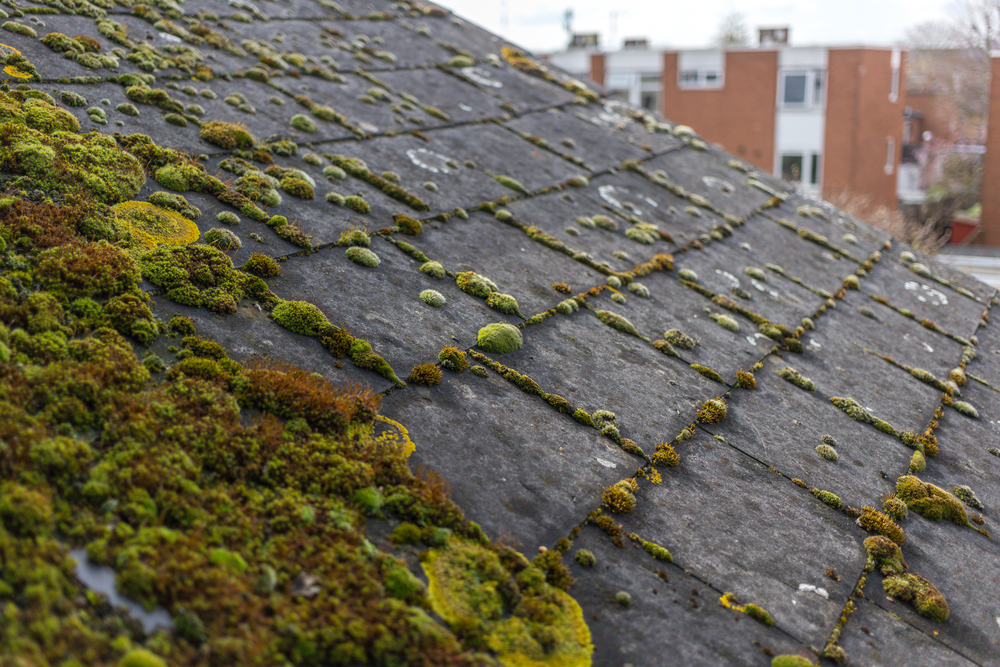The presence of algae on roofs is a common concern for many homeowners, affecting not only the aesthetic appeal of their homes but potentially leading to long-term structural issues. Understanding the causes of algae growth and implementing effective removal strategies are essential steps in maintaining the health and appearance of your roof.
Understanding Algae Growth on Roofs
Algae growth on roofs is particularly seen in the form of dark streaks or patches. It is primarily caused by Gloeocapsa magma – a type of cyanobacteria known for its hardy nature and ability to thrive in diverse environmental conditions. Algae spores are airborne and can easily settle on your roof if they find a conducive environment for growth.
Understanding the biological nature of algae can help you take more targeted action in its removal and prevention. It’s interesting to note that algae’s resilience is largely due to its protective outer layer, which shields it from UV rays. This protective mechanism allows algae to survive even under direct sunlight, making it a persistent issue on roofs regardless of climate.
Recognizing this can guide you in selecting the most effective products and methods for treating algae, emphasizing the need for solutions that penetrate this layer for lasting results.
Environmental Conditions Fostering Algae Growth
Several environmental factors contribute to the proliferation of algae on roofs:
- Limestone Fillers: Modern asphalt shingles often contain limestone fillers as a weight additive. Algae feed on the limestone, leading to faster growth and spread.
- Moisture: Algae requires moisture to grow. Humid climates or areas with frequent rainfall provide ideal conditions for algae proliferation.
- Shade: Roofs that receive limited sunlight due to shade from trees, buildings, or other structures are more susceptible to algae growth because the shade keeps the roof surface moist for longer periods.
Professional Vs. DIY Removal Methods
When it comes to removing algae from your roof, there are both DIY and professional methods available. However, each approach requires careful consideration to ensure the safety and integrity of your roof.
· DIY Methods
DIY methods typically involve applying a cleaning solution to kill the algae. Solutions can range from store-bought products designed for roof cleaning to homemade mixtures like bleach and water.
· Professional Cleaning Services
For homeowners who prefer not to tackle this task themselves or have concerns about safety, professional cleaning services like Hot Wash offer a safe and effective solution. We offer specialized power washing services in Dallas and Fort Worth with techniques and equipment designed to remove algae without damaging the roof.
Opting for professional washing services ensures that the job is done efficiently and effectively, with minimal risk to your roof or personal safety.
Preventive Measures
Beyond removal, taking steps to prevent algae growth is key to maintaining a clean roof over the long term:
- Consider Algae-Resistant Shingles: When it’s time for a roof replacement, choosing algae-resistant shingles can significantly reduce the likelihood of algae growth.
- Improve Air Circulation: Ensure your attic is well-ventilated to decrease moisture buildup under the roof.
- Regular Roof Maintenance: Keep gutters clear and trim overhanging branches to reduce shade and moisture on the roof.
Safeguarding Your Roof Against Algae
Maintaining a clean roof free from algae is vital for both the aesthetic appeal and structural health of your home. By understanding the causes of algae growth and adopting effective removal and preventive measures, you can protect your investment. Contact us today for professional power washing services.
